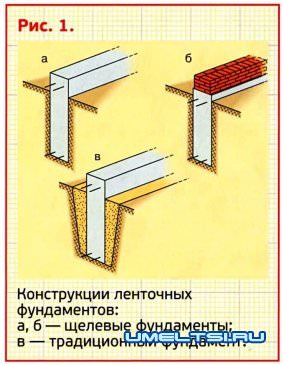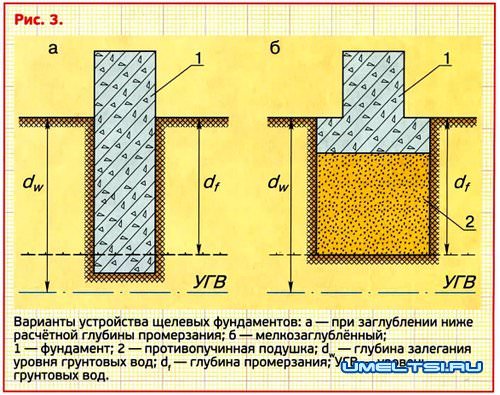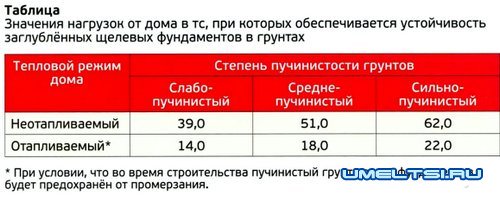If the team invited by you to make the foundation offers to cast a monolithic reinforced concrete strip directly in the ground, be careful. For them, it is easier to manufacture, but for you it may simply be unacceptable. The specialist talks about the features of the application of such a design.
A slotted reinforced concrete foundation is called a monolithic tape reinforced concrete foundation of a rectangular section, in the manufacture of which concrete is laid directly into a dug trench - “into the spacer” of the soil. They are usually made in bound clay soils; they are not used in sandy soils, since the walls of the trench will crumble in them. 
The plinth can be made as a single structure with a foundation or separately - in the form of brick or block masonry (Fig. 1a, b). In the first case, the formwork is set from the ground surface to the height of the base.
Slotted foundations are more economical than traditional foundations built in trenches using formwork (Fig. 1c). Therefore, they are more attractive in the construction of low-rise buildings.
Features of slot foundations
In traditional strip foundations, the load from the house to the foundation is transferred through the sole. Backfill soil resistance is not taken into account in the calculations.
When constructing slotted foundations, due to the uneven sides of the trenches and dense (with vibration compaction or bayonet) concrete laying, a good adhesion of the side surface of the structure to the soil is obtained, which can take a significant part of the load from the house. Therefore, to obtain economical structures, the calculations take into account the resistance of the soil both along their sole and along the side surface. As will be shown below, this is not achievable in all soil conditions.
Slotted foundations laid below the freezing depth are calculated on the basis of sediment deformations and on resistance to the effects of tangential heaving forces. For shallow-depth slotted foundations in heaving soils, in addition to the above calculations, it is necessary to carry out a calculation according to the allowable heaving deformations. If the area of the sole of slotted structures is determined by the allowable soil resistance calculated on the basis of its physical and mechanical characteristics, then precipitation will be within acceptable limits and a separate calculation is not required.

Since the vast majority of construction sites are represented by heaving soils, for buried slotted foundations under low-rise buildings, the main thing is the calculation for stability, and for shallow ones, the calculation for both stability and heaving deformations.
For buried structures, stability is ensured by exceeding the design load from the house over the maximum total tangential heaving forces (Fig. 2, curve 2). In this case, heaving deformations are equal to zero.
For shallow foundations, heaving deformations should be equal to zero when the soil freezes to the depth of their soles. Stability in this case is ensured at much lower total heaving forces than in buried foundations.
Slotted foundations in heaving soils
Soil freezing starts from the surface. As the freezing front moves into the thickness of the heaving soil along the side surface of the foundations, tangential heaving forces arise, which increase with decreasing air and soil temperatures (Fig. 2, curve 1).
The cementing component in the soil is ice. Freezing it with a concrete surface depends on the temperature of the soil. For example, in the Moscow region, negative average monthly temperatures reach a maximum in January (Fig. 2, curve 3). In the same period, the specific tangential forces reach their maximum value. Later, with a decrease in the average monthly temperature in February, the specific tangential forces decrease, but the total forces continue to increase for some time due to an increase in the freezing depth, and then also decrease (Fig. 2, curve 2).
IF THE LOADS FROM THE HOUSE ARE EQUAL TO OR EXCEED THE CALCULATED TOTAL TANGENT FORCES OF HEAVING, THEN THE FOUNDATION WILL BE STABLE AND THE DEFORMATIONS OF HEAVING ARE ZERO.
If the loads from the house are less than the total tangential heaving forces, then the foundation will move along with the soil. In this case, the sole comes off the base, and a cavity forms under it, where soil can get from the walls of the trench during the spring subsidence of the house. This causes the accumulation of residual heaving deformations.
In the spring, the foundation may not return to its original position even if the load from the house is less than the friction forces of the soil. This phenomenon is often observed when using recessed slotted foundations for low-rise buildings built on heaving soils.
The upward movement of the building indicates instability and, consequently, the unreliability of the foundation.
If the slot foundation is made in the form of a spatial rigid frame and the bending resistance of the cross section is sufficient to preserve the above-foundation structures, then the heaving deformations do not damage the wall masonry in houses made of brick or other masonry materials. However, a roll of the whole house is formed, which can increase over the years.
When using shallow-depth slotted foundations, the stability of the building is ensured by choosing the appropriate laying depth (Fig. 36), and the permissible heaving deformations are ensured by arranging an anti-heaving pillow in the trench under the foundation.

As a result, significant savings in concrete are also obtained.
However, it should be borne in mind that as the foundations are deepened, it may be necessary to increase the width of their supporting part. In this case, the base can be left the same width.
If groundwater during work is located above the freezing depth, then it will not be possible to arrange a reliable foundation by ramming an anti-flood cushion. Therefore, the trench should be developed at a depth of 10-20 cm above the water level, and allowable heaving deformations should be ensured by widening the trench. That is, in this case, they proceed to the construction of conventional shallow foundations.

Design features of slot foundations
The load from the house is perceived by the soil both along the side surface of the foundation and under its sole. If the base soils are non-rocky, then the allowable load on the foundations can be calculated as the sum of the calculated soil resistances. If the soils are slightly heaving, then the allowable load on the foundations should be taken only according to the calculated soil resistance under the sole. If the soils are medium or strongly heaving, then the allowable load should be taken according to the calculated resistance of the soil under the sole, taking into account the increase in the load on the foundations due to the negative friction of the soil that occurs in the spring on their lateral surface.
This is the first feature of the design of slotted foundations that requires explanation. In the spring, when the swollen soil is soldered, the process of its consolidation (compaction) and subsidence begins. Due to the increased roughness of the side surface, part of the soil hangs on the foundations. The so-called negative (negative) friction appears. The overall load on the foundations increases.
Such interaction of foundations with soil lasts only a short time in spring, but it occurs from year to year and can cause increased settlement of foundations.
The second feature that should be taken into account when designing slotted foundations is that due to the same roughness of the side surface, tangential heaving forces increase, which should be taken into account when calculating foundations for stability.

We will not touch on the features of the calculations. It is important that we can obtain the values of loads from the house, which ensure the stability of deep slotted foundations in heaving soils and, therefore, the possibility of their use. The table below shows the values of such loads at a standard freezing depth of 1.4 m. The experience of many years of calculations of low-rise buildings shows that the range of characteristic loads for all houses is 2.0-14.0 tf/m. In brick two-story houses, loads on individual foundations can reach 18.0 tf/m. As you can see, the area of reliable application of deep slotted foundations in heaving soils under low-rise buildings is significantly limited.
Conditions for the reliable use of slotted foundations
1. The vertical walls of the trenches should not collapse until the end of the concrete placement.
2. The groundwater level during work must be below the bottom of the trenches.
If, as a result of past rains, puddles have formed at the bottom of the trenches, they must be scooped out. If the soil in these places has come to a fluid or fluid-plastic state, it must be cut to the level of its original state.
3. Recessed slotted foundations in non-rocky soils are applicable in terms of stability under all houses, regardless of the thermal regime of the house, as well as under brick heated houses with two (and more) floors in slightly heaving soils. In all other cases, deep slotted foundations are not applicable under low-rise buildings in heaving soils due to the condition of reliability.
L. Ginzburg, candidate of technical sciences